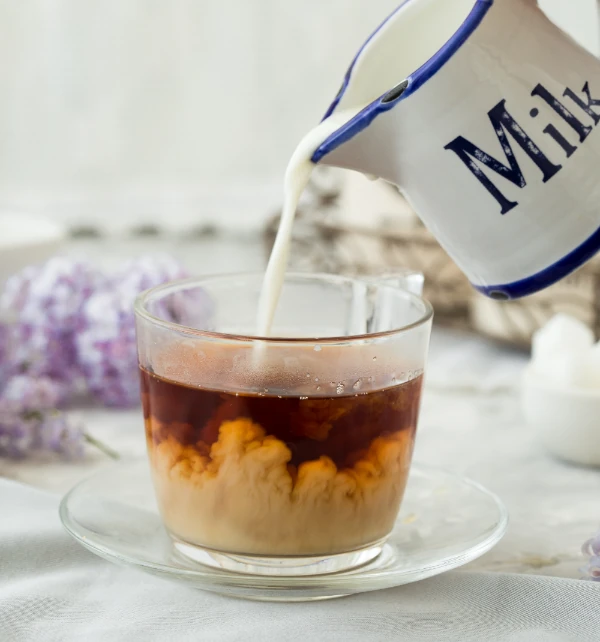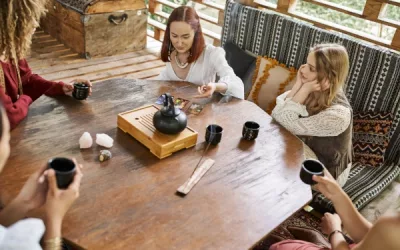Have you ever found yourself in the midst of the Great Tea Debate: milk or no milk? This age-old question transcends taste buds, revealing deep cultural ties and personal preferences. As tea enthusiasts and casual drinkers alike explore the complexities of this beloved beverage, understanding the historical, health, and social implications of adding milk becomes essential. This article will dive into the nuances of the milk debate, offering insights into brewing methods, cultural practices, and the latest alternatives, helping you navigate your own tea journey.
Table of Content
- What is the historical significance of milk in tea?
- What Are The Brewing Preferences For Tea With And Without Milk?
- What are the popular types of tea served with milk?
- What are the health considerations when adding milk to tea?
- How do different cultures approach the milk-in-tea debate?
- What are some popular dairy-free alternatives for tea?
- What are the common myths about adding milk to tea?
- How can tea drinkers engage in the milk debate?
- Conclusion
What is the historical significance of milk in tea?
Milk in tea has a fascinating history that spans continents and centuries. It is not just about adding a creamy texture to your cuppa, but also about cultural practices and historical evolution. The British tea tradition, colonial influences, and regional variations all play a role in how milk found its way into tea. Tea ceremonies and individual preferences have all evolved over time, shaping the modern tea-drinking experience.
During the British colonial era, tea became a symbol of sophistication and social status. Adding milk was a way to cool down the hot tea without cracking fine china cups, thus preserving the delicate porcelain. This practice quickly became a cultural norm. Over time, different regions adapted the tradition to their tastes, with some preferring strong, milky brews, while others favoured lighter infusions.
How did the practice of adding milk to tea begin?
The practice of adding milk to tea has its roots in British high society. In the 17th century, tea was an expensive import, enjoyed mainly by the wealthy. The fine china cups used at that time were delicate and could crack from the heat of boiling tea.
Adding milk helped to cool down the tea, preventing the cups from breaking. This practical measure soon became a cultural habit.
- British merchants imported tea from China, making it a luxury item.
- Fine china cups were highly valued and required careful handling.
- Milk was added to cool the tea and prevent cracking.
- This practice became a social norm among the British elite.
- Over time, it spread across different social classes and regions.
As tea became more accessible, the habit of adding milk continued. The British colonial influence also spread this practice to other parts of the world, including India and Africa. Each region adapted the custom to fit their own cultural context, creating unique variations of milk tea.
What cultural factors influence the choice to add milk?
Several cultural factors influence the choice to add milk to tea. These include historical traditions, regional preferences, and social norms. In Britain, milk tea has become a staple, deeply ingrained in daily life and social rituals.
In other parts of the world, the influence of British colonialism introduced the concept, which was then adapted to local tastes.
- Historical traditions from the British high society.
- Regional preferences vary, with some cultures favouring stronger or spicier teas.
- Social norms and rituals, like the British afternoon tea.
- Influence of colonial history in countries like India and Kenya.
- Personal preferences and family habits passed down through generations.
In India, for example, chai is a popular variation that includes tea, milk, sugar, and spices. This blend reflects local tastes and ingredients, showing how the basic idea of milk tea can be customised to fit different cultural contexts.
In contrast, Japan and China, with their rich tea traditions, generally prefer unadulterated tea, focusing on the natural flavours of the tea leaves.
How has the perception of milk in tea changed over time?
The perception of milk in tea has evolved significantly over the years. Initially, it was a practical solution to a problem faced by tea drinkers. Over time, it became a marker of social status and sophistication. Today, it is a matter of personal preference, with some tea enthusiasts swearing by milk and others preferring their tea without it.
- Initially a practical measure to protect delicate china.
- Became associated with sophistication and high society.
- Spread globally due to British colonial influence.
- Now a matter of personal preference and regional variation.
- Modern tea culture embraces both milk and non-milk variations.
Nowadays, the debate over adding milk to tea can be quite passionate. Some argue that milk enhances the flavour and adds a comforting creaminess, while others believe it masks the delicate flavours of the tea leaves. The Great Tea Debate continues, reflecting the diverse and evolving nature of tea culture.
The story of milk in tea is closely linked to the British East India Company. In the 18th century, the company had a monopoly on tea imports from China. Tea was a luxury, and the British aristocracy adopted elaborate rituals around its consumption.
Fine porcelain cups were a status symbol, so the practice of adding milk to cool the tea became fashionable. This practice spread through British society and then to its colonies, influencing tea cultures around the world.
I remember visiting my grandmother in the English countryside. She had a specific way of making tea, always adding a splash of milk before the hot tea. She said it reminded her of her own grandmother, who would carefully prepare tea in fine china cups.
For her, adding milk was not just about the taste but a way to connect with family history and traditions. Each sip felt like a warm hug from the past, a simple yet profound ritual that brought generations together.

What Are The Brewing Preferences For Tea With And Without Milk?
Brewing tea is an art that varies greatly depending on personal taste and cultural preferences. Whether you prefer your tea with or without milk, the brewing method can significantly impact the taste and experience. This guide will help you navigate the world of tea brewing by breaking it down into simple steps, whether you enjoy a splash of milk in your cup or prefer it pure and straightforward.
Let’s dive into the details of brewing preferences. Understanding these aspects will not only enhance your tea drinking experience but also allow you to appreciate the diverse world of tea. Below, you’ll find a handy table that summarises the brewing times, temperatures, and milk compatibility for various types of tea.
Different Brewing Preferences For Tea With And Without Milk
Below is a table that you can use to brew different types of tea. It includes the recommended brewing times, temperatures, and whether the tea pairs well with milk. This information will help you achieve the perfect cup every time.
| Tea Type | Brewing Time | Temperature (°C) | Milk Compatibility | Notes |
|---|---|---|---|---|
| Black Tea | 3-5 minutes | 90-95 | High | Strong, robust flavour ideal for milk |
| Green Tea | 2-3 minutes | 70-80 | Low | Delicate, best enjoyed without milk |
| Oolong Tea | 3-5 minutes | 85-90 | Medium | Can be enjoyed both ways |
| White Tea | 4-5 minutes | 75-80 | Low | Subtle flavours, usually milk-free |
| Chai Tea | 5-7 minutes | 90-95 | High | Traditionally enjoyed with milk and spices |
| Herbal Tea | 5-7 minutes | 95 | Low | Varied flavours, generally without milk |
| Assam Tea | 4-5 minutes | 90-95 | High | Bold, malty flavour, great with milk |
| Earl Grey | 3-4 minutes | 85-90 | Medium | Citrus notes, can be enhanced with a dash of milk |
The table shows the recommended brewing times and temperatures for various teas, along with their compatibility with milk. For instance, black tea and chai tea have high milk compatibility due to their strong flavours, while green tea and white tea usually don’t pair well with milk because of their delicate notes.
Tea Brewing Tips
Brewing tea perfectly requires a bit of knowledge and lots of practice. Following these tips can help you get the most flavour out of your tea leaves:
- Use Fresh Water: Always use fresh, filtered water to ensure the best taste.
- Preheat Your Teapot: Pour a bit of hot water into your teapot and let it sit for a few moments. This helps to maintain the water temperature.
- Measure Your Tea: Use the right amount of tea leaves for the best flavour.
- Monitor Brewing Time: Over-brewing can make your tea bitter, so keep an eye on the time.
Different teas require different approaches. For example, black tea thrives in hotter water and longer brewing times, which allows its robust flavours to develop fully. In contrast, green tea needs cooler water and shorter brewing to avoid bitterness and preserve its delicate taste.
Milk Compatibility
Whether to add milk to your tea depends largely on the type of tea and your taste preference. Some teas naturally pair well with milk, while others are best enjoyed on their own:
- High Compatibility: Black, chai, and Assam teas benefit from milk, which helps to balance their strong flavours.
- Medium Compatibility: Oolong and Earl Grey can be enjoyed with or without milk, depending on your preference.
- Low Compatibility: Green, white, and most herbal teas are best savoured without milk to appreciate their subtle notes.
Understanding which teas work well with milk can enhance your overall tea drinking experience. For example, adding milk to Assam tea brings out its malty richness, while leaving green tea plain allows you to enjoy its refreshing, grassy notes.
In the late 1800s, Anna, the Duchess of Bedford, popularised the British tradition of afternoon tea. She would become hungry around four o’clock in the afternoon and wanted something small to satisfy her appetite until dinner.
She started inviting friends over for tea and light snacks, which eventually evolved into a fashionable social event. This ritual often included black tea with milk, finger sandwiches, and pastries, highlighting how tea culture has been shaped by historical figures and social practices.
When I first explored the world of teas, I was overwhelmed by the choices. One rainy afternoon, I brewed a pot of Assam tea, adding a splash of milk out of curiosity. The transformation was incredible; the strong, malty flavour became smooth and rich.
Since then, Assam tea with milk has become my go-to comfort drink. It’s fascinating how a simple addition can elevate the experience and teach you so much about the nuances of tea.
What are the popular types of tea served with milk?
Alright, tea junkies, lean in because we’re diving headfirst into the frothy waters of the Great Tea Debate – the milk-in-tea controversy. We’ll hit the obvious classics, unveil some hidden gems, and maybe ruffle a few purist feathers along the way.
First up, let’s talk about why we even bother splashing our beloved brew with cow juice in the first place. The answer is simple: it’s freakin’ delicious. But not all teas play nicely with milk.
Some mingle like lifelong pals, while others throw a tantrum and curdle into oblivion. So, which teas love a good milk bath? Let’s break it down.
Which black teas are traditionally served with milk?
The black tea varieties that can’t get enough of the white stuff are:
- Assam: This Indian beauty is robust and malty. Think of it as the bodybuilder of teas – it can handle the creaminess without losing its punch.
- English Breakfast: The reliable old-schooler. It’s a blend typically made of Assam, Ceylon, and occasionally Kenyan tea. Solid, dependable, and endlessly comforting.
- Earl Grey: A genteel classic. The touch of bergamot oil gives it a floral, citrusy flair that’s surprisingly dreamy with milk.
- Chai: Not a single perso. I can hear the collective “duh” from all the chai lovers out there. Spicy, creamy, warming – it’s basically a hug in a cup.
- Ceylon: Known for its bright, bold flavour and slight citrus kick. Milk smooths out its assertive edge, making it a bit more mellow without compromising the zing.
Each of these teas has something special about them that gets a thumbs-up in the milk department. Whether it’s the full-bodied character or the aromatic complexity, they all dance rather splendidly with a dash of dairy.
How does milk affect the flavour of these teas?
So, you might be thinking, “Why the heck should I even bother changing my tea’s flavour with milk?” Well, here’s how it redefines your sipping experience:
- Smooths Bitterness: Milk takes the edge off any tannins, which can make your tea taste less like a dry handshake from a stranger.
- Enhances Body: It adds a creamy, velvety texture – you can almost feel the tea giving you a warm cuddle.
- Balances Flavours: Especially with chai and Earl Grey, milk melds the spices and bergamot into a harmonious blend, making every sip feel rounded.
- Sweetens Naturally: Milk has this nifty trick of bringing out the natural sugars in the tea leaves, so it’s like a gentle sweetener without dumping an actual kilo of sugar in your cup.
- Aromatic Dance: Milk can sometimes highlight the floral, fruity, or smoky notes in your tea, turning a simple cuppa into a full-on sensory experience.
These tweaks make the magic happen, transforming your tea from a mere drink into an event worth Instagramming.
Are there any teas that should never be served with milk?
Oh yes, indeed. While some teas and milk are a match made in heaven, others are like oil and water – they just don’t mix. Here’s a hit list of teas that would rather go solo:
- Green Teas: Light, grassy, and sometimes nutty – adding milk is like putting ketchup on your caviar.
- White Teas: Delicate and floral, they’d get completely bullied by milk. It’s a flavour massacre.
- Oolong Teas: These guys are complex and subtle, ranging from fruity to floral. Milk just muddles the symphony going on in your cup.
- Herbal Teas: Teas like chamomile, peppermint, or rosehip don’t have that tannic backbone to support milk, leaving you with a cup of confusion and regret.
- Matcha: I know, I know – matcha lattes are a thing. However, traditional matcha is all about the vibrant green and umami notes. Milk dulls that vibrant kick and turns it into a murky mess.
Stick to enjoying these teas in their pure, unadulterated glory, and you won’t regret it.
Now, since we’re waxing poetic about tea, did you ever hear about how tea drinking became an English staple? It all kicked off in the 17th century with King Charles II and his Portuguese bride, Catherine of Braganza.
She was the O.G. influencer who brought her tea-drinking habit to the English court. Before long, everyone’s pinkies were up, sipping on the exotic brew. So when you sip your next milky cup, you’re not just drinking tea – you’re practically royalty, darling.
What are the health considerations when adding milk to tea?
Before you dash for that milk jug, let’s take a look at whether adding milk to your tea is a good idea or if it’s actually sabotaging your efforts to live a long, healthy life. Spoiler alert: there’s a bit of both!
We’ll explore lactose intolerance, antioxidants, alternative milk options, sugar content, and personal dietary preferences. Stick with me, and we’ll uncover if your cuppa, with or without milk, is still a health hero.
Adding milk to tea is like adding a plot twist to a simple story. Sometimes it’s a great addition; other times, it’s a complete disaster. There are nutritional benefits – proteins, calcium, Vitamin D – yet potential drawbacks lurk in the shadows. Here’s the rundown for you:
How does milk affect the health benefits of tea?
Adding milk to tea can do a little dance with the nutritional benefits, twisting and turning them in unexpected ways. Here’s what happens:
- Antioxidant impact: Tea is a well-known antioxidant powerhouse, particularly for catechins. Milk, however, may reduce these good guys’ bioavailability.
- Nutrient addition: Milk provides proteins, calcium, vitamins like B12 and D, which are crucial for bones and muscles.
- Lactose factor: For lactose-intolerant folk, milk can wreak havoc on your digestive system, turning tea time into tummy trauma.
- Calorie increase: Adding milk does bump up the calorie count, so if you’re watching your waistline, it’s worth considering.
- Sugar combo: Milk can sweeten the deal, but don’t forget that too much sugar can lead to other health issues.
So, milk can both enhance and compromise tea’s health perks. If you don’t have lactose issues and you control sugar intake, milk can be a beneficial addition. But remember, moderation is key.
What are suitable alternatives for those with lactose intolerance?
Not all tea drinkers are created equal, and if you’re lactose intolerant, milk is more foe than friend. Fear not, dear reader, for alternatives are aplenty:
- Soy milk: Rich in protein, soy milk is a popular alternative. Some studies even suggest it helps maintain the tea’s antioxidant prowess.
- Almond milk: Low in calories and packed with vitamins like E, almond milk is a tasty alternative, though it’s lighter.
- Oat milk: Creamier than other plant-based options, oat milk is an excellent choice for that rich tea texture.
- Coconut milk: Brings some tropical flair to your tea but watch that sweetened variety.
- Rice milk: Light on the tummy, though it has a thinner texture and less nutritional benefit in comparison.
These alternatives not only cater to your lactose-free needs but also provide their own sets of perks and flavours, keeping your tea time tasty and tummy-friendly.
Can adding milk to tea be part of a healthy diet?
Good news! Milk in tea can indeed fit into a balanced diet. Here’s how you make sure it works for you:
- Portion control: A splash of milk is usually enough. There’s no need to drown your tea.
- Choose wisely: Opt for low-fat or skimmed milk varieties to keep calorie count in check.
- Balance: Look at your overall diet and ensure you’re getting a mix of nutrients from other sources too.
- Frequency: Daily intake of milk tea is okay for most people, but mix it up. Go for green tea, black tea, and even herbal concoctions.
- Add-ins: Keep an eye on sugar and syrup additions. They can spike calorie content sneakingly.
Balancing milk tea within a varied diet can help you reap the benefits while avoiding potential pitfalls. Remember, moderation is your best friend.
Ah, and let me leave you with a little tidbit from history. Did you know that the British started adding milk to tea in the 1700s to cool down fine porcelain cups and avoid cracking them? Enterprising and delicious!
It’s fascinating how centuries ago, people found resourceful ways to enjoy their favourite brew while protecting their precious teacups, unwittingly creating the foundation for today’s great tea debate.
How do different cultures approach the milk-in-tea debate?
Alright, folks, let’s take a world tour of tea cups and see how different cultures weigh in on the ever-contentious milk-in-tea debate. Imagine this as a cultural buffet, but with tea as the main course. By the end of this, you might just ditch your usual tea routine for something a bit more exotic or traditional. You never know.
In jolly old England, adding milk to tea is as routine as complaining about the weather. Brits typically brew a strong black tea—think Assam or English Breakfast—and then add a splash of milk.
It’s a comforting ritual that’s practically a national pastime. Over in India, the beloved chai is not merely a drink; it’s a cultural icon. Boiling a mixture of black tea, spices like cardamom and ginger, and, yep, a generous amount of milk, chai is as essential to India as cricket and Bollywood.
Meanwhile, the Chinese approach tea like an art form. Traditional Chinese tea ceremonies feature a variety of teas—green, oolong, and pu-erh—that are typically enjoyed without any additives, milk included.
This practice preserves the delicate flavours and aromas of the tea leaves. In the Middle East, particularly in nations like Morocco and Iran, tea is often served strong and sweet. Milky tea isn’t the norm here, though variations occur.
Lastly, modern tea trends like bubble tea from Taiwan mix the classic and the contemporary, offering teas with milk, fruit, and even odd but delightful additions like tapioca pearls.
Each of these regions has its own unique relationship with tea, influenced by history, climate, and taste preferences. Whether you’re a purist or a modern adventurer, there’s a cup of tea (or five) out there with your name on it.
What cultural factors influence tea preparation?
Ah, the million-dollar question: why does everyone make tea differently? Turns out, cultural factors are the unsung heroes—or villains, depending on your stance—in the milk-in-tea debate. Let’s break it down.
Religion, climate, historical trade routes, and social norms all roll into this complex equation. For example:
- Climate: In colder climates like Britain, adding milk to tea provides extra warmth and comfort. Conversely, in hotter regions like India, the spices in chai can help regulate body temperature.
- Historical Trade Routes: The British Empire’s global influence spread their fondness for milky tea far and wide, impacting countries like India and Sri Lanka.
- Social Norms: Afternoon tea in Britain is a social event, involving not just tea but cakes, scones, and sandwiches. This lends itself to a more elaborate preparation method.
- Religion: Some religious practices influence what can or cannot be added to tea. For instance, many Buddhists prefer the pure experience of Chinese teas, devoid of any additives.
The blending of these factors creates a unique tea culture in each region. Pretty fascinating, right?
How do different countries serve tea with or without milk?
Brace yourself, because sampling tea around the world is going to be like attending an international food fest, but for your taste buds. Grab your passport—here’s a quick rundown of how tea is served across nations.
- United Kingdom:
- Typically black tea with a splash of milk.
- Often paired with biscuits or scones.
- India:
- Chai is a robust blend of black tea, spices, and milk.
- Served in small glasses or clay cups.
- China:
- Largely green, oolong, or pu-erh teas, usually enjoyed sans milk.
- Traditional tea ceremonies highlight the tea’s natural flavours.
- Middle East:
- Mint tea in Morocco, often served sweet, sometimes with a splash of milk.
- Black tea in Iran, typically strong and sweet, rarely with milk.
- Taiwan:
- Bubble tea mixes black or green tea with milk, fruit flavours, and chewy tapioca pearls.
- Served cold, often in large cups with oversized straws.
Taste experiences vary as much as the ways tea is served. The culture, cuisine, and climate all contribute to these habits.
What can we learn from international tea practices?
Beyond just quenching our thirst, tea customs worldwide teach us about tradition, social etiquette, and even health benefits. Here are some nuggets of wisdom we can glean.
- Respect for Ingredients: Chinese teas are all about appreciating the purity and quality of the tea leaves.
- Social Connection: British and Indian tea times are pivotal social experiences, fostering community and conversation.
- Health Benefits: Many cultures, like in Morocco, blend herbs like mint for added health benefits, showcasing natural remedies.
- Culinary Creativity: Modern innovations like Taiwan’s bubble tea prove that tradition and creativity can co-exist beautifully.
- Mindfulness: Traditional tea ceremonies, especially in Japan and China, instil a sense of peace and mindfulness.
By adopting these practices, we can enrich our tea-drinking experiences and perhaps even our daily lives.
A historical tidbit to chew on: During World War II, Britain faced a tea crisis due to the German naval blockades. To counteract this, the government established the Tea Division to ensure the supply chain continued. The result?
Tea became more than a beverage; it turned into a morale booster for British citizens and soldiers. It’s a testament to how deeply woven into the fabric of society tea can be, especially when times get tough. So next time you sip your tea, know that you’re drinking a piece of history.
What are some popular dairy-free alternatives for tea?
Imagine, if you will, the Great Tea Debate. No, seriously, pop the kettle on and let’s talk about the rise of dairy-free alternatives. Because let’s face it, whether you’re lactose-intolerant, vegan, or just curious, making the perfect cup of tea without traditional cow’s milk is worth a discussion.
Let’s dive into five non-dairy contenders and see how they hold up against the mighty tea: soy milk, almond milk, oat milk, coconut milk, and hemp milk.
Which dairy-free alternatives taste best with tea?
You might be wondering which of these alternatives will best compliment your Earl Grey or matcha madness. Let’s stir things up a bit:
- Soy milk: Creamy, often likened to dairy milk in texture, but it can sometimes have a beany aftertaste. Works well in strong teas like black and chai.
- Almond milk: Nutty and slightly sweet. Perfect for delicate teas like green or white tea.
- Oat milk: Sweet and smooth, it froths up beautifully making it ideal for tea lattes. Go for it with your breakfast tea.
- Coconut milk: Exotic and creamy with a slight coconut flavour. Fantastic with fruity teas or anything tropical.
- Hemp milk: Earthy and nutty. A go-to for herbal teas or anything needing a robust partner.
All these options are like your squad of best mates – each with their own quirks, they bring something unique to the table.
How do these alternatives compare nutritionally to dairy milk?
Beyond just flavour, you ought to know if these alternatives stack up nutritionally to dairy milk. Spoiler alert – they do, and sometimes they bring extra to the party:
- Soy milk: High in protein, comparable to dairy, and typically fortified with vitamins B12 and D.
- Almond milk: Low in calories, but not much protein. Packed with vitamin E though!
- Oat milk: Higher in sugar and calories but also has fibre and beta-glucans, which are good for the heart.
- Coconut milk: Low in protein, higher in fat (the good kind), and quite calorific.
- Hemp milk: A decent protein source and rich in omega-3 and omega-6 fatty acids.
If you’re counting calories, need extra protein, or simply want vitamins, there’s a dairy-free alternative for you. Each one is like a customisable character in a video game – you can pick the features that best suit your needs.
Are there any specific teas that pair well with dairy-free options?
Now let’s talk matchmaking. Some dairy-free milks are as picky as Tinder dates; not all teas will woo them successfully. Here are the dream teams:
- Chai Tea and Soy Milk: The robustness of chai spices goes perfectly with creamy soy.
- Green Tea and Almond Milk: Delicate notes are enhanced by the nutty sweetness.
- Breakfast Tea and Oat Milk: Start your day with a smooth, hearty blend.
- Herbal Teas and Hemp Milk: Earthy mates bringing out each other’s best.
- Fruit Teas and Coconut Milk: Boost that tropical vibe.
It’s all about finding balance – like a good conversation, each party should bring something to the interaction while letting the other shine.
Now, let me share a nugget from history that beautifully ties into our title – the Great Tea Debate. Back in the 1660s, when tea first started gaining popularity in Britain, it was an elite affair.
Catherine of Braganza, the Portuguese wife of King Charles II, brought her love of tea to the English court. While tea was initially a bit of an exclusive club drink, it soon crossed social boundaries. By the 19th century, tea time had become a quintessential British custom.
Imagine the hullabaloo if dairy-free alternatives were introduced back then – Shakespeare probably would’ve penned his next comedy on it. The world of tea has come far, evolving with the times, keeping its charm while embracing diversity in every sip.
So, next time you sip that dairy-free brew, remember you’re part of an ever-evolving tradition. Cheers to that!
What are the common myths about adding milk to tea?
Alright, let’s dive into the murky waters of the Great Tea Debate. First off, there are a ton of myths about adding milk to tea. Some are laughable, some are pervasive, and a few are just plain wrong. So, put on your kettle, steep your tea, and let’s debunk these misconceptions.
For one, there’s a myth that says adding milk to tea ruins it. This couldn’t be further from the truth. Another persistent myth is the argument about whether milk should be added before or after brewing – a debate so intense that it should have its own reality show. Lastly, people often think adding milk is a sign of poor-quality tea. Spoiler alert: it’s not.
Let’s dissect these myths and serve you the facts.
What are the most common myths about milk in tea?
Let’s start with the myths that have been brewed for too long.
- Milk ruins tea: Some purists will tell you milk destroys the delicate flavours of tea. That’s like saying putting cheese on a pizza ruins the tomato sauce. But science tells us milk can actually enhance certain aspects of the beverage.
- Add milk before or after brewing: This one is as divisive as pineapple on pizza. Some argue adding milk first helps prevent scalding the tea. Others say adding it afterward allows you to control milk quantity better.
- Poor tea quality: The thought here is that if you’re adding milk, you’re obviously hiding some low-grade, floor-sweepings masquerading as tea. Totally wrong. Many high-quality teas pair wonderfully with milk.
These myths have been floating around like loose leaf in a pot, but they don’t stand up to scrutiny. So next time someone tries to throw these half-baked ideas your way, you can shut them down with some well-brewed knowledge.
How can misinformation affect tea enjoyment?
Ah, misinformation – the nemesis of tea enjoyment. When people buy into these myths, it turns tea drinking into a stressful activity, like preparing for a fancy dinner with royalty. It can also create some pretty nasty tea faux pas that ruin the experience altogether.
- Unnecessary stress: Falling for these myths can make you second guess every step in your tea-making process, turning a relaxing ritual into a caffeine-induced stress-fest.
- Taste misadventures: Misguided attempts can lead to subpar tea. You deserve better than that, my tea-loving friend.
- Peer pressure: People might avoid adding milk altogether just to seem “proper,” missing out on the rich, creamy versions of their favourite drinks.
- Lost enjoyment: The fear of “getting it wrong” can rob you of the simple pleasure of enjoying a cuppa.
The moral here? Don’t let myths direct your tea journey. Take charge, sip confidently, and find what you love.
What truths exist behind these myths?
Now, what about the kernels of truth in these myths? Even a broken clock is right twice a day, and these myths aren’t completely groundless – just highly exaggerated.
- Milk and flavour: Sure, if you’re drinking a delicate white tea, adding milk might overshadow some of its subtle notes. But for strong blacks and chai, milk can blend beautifully, balancing out astringency.
- Order of operations: There’s some merit to the idea that milk first can help control temperature for some teas, particularly traditional British black teas. But in modern times, the order largely comes down to personal preference.
- Quality concerns: Look, if you’re drinking high-grade Oolong, you might skip the milk out of respect for those complex flavours. But good-quality black teas and certain blends are designed to be enjoyed with milk.
A spot of milk in tea has historical roots as well. Back in the day, it was added to delicate china cups to prevent cracking from sudden temperature changes. Practical, right? So, next time someone tells you that milk ruins tea, tell them it was once China’s lifesaver.
Around the 17th century, when tea was becoming all the rage in Europe, Catherine of Braganza, a Portuguese princess married to England’s King Charles II, popularised adding milk. Her love for tea set such a trend that even the British aristocracy couldn’t resist.
So, adding milk isn’t just a modern whim; it’s steeped in history, just like your favourite brew.
Bust those myths, enjoy your tea, and remember – there’s no wrong way to drink it!
How can tea drinkers engage in the milk debate?
Ah, the great milk debate! A topic so divisive, even the most civilised tea parties can quickly turn into heated debates. Should one add milk before or after pouring the tea? It’s a question that has caused many a raised eyebrow and furrowed brow. But fear not, tea enthusiasts! There are plenty of ways to dive into this delightful conundrum. Let’s get straight to the tea—erm, point.
First off, the virtual world is your oyster when it comes to engaging in tea discussions. Platforms like Twitter, Instagram, and Facebook are brimming with tea enthusiasts ready to share their milk preferences (and sometimes their strong opinions!).
What platforms are best for discussing tea preferences?
Let’s break it down. Social media is your go-to tool for this. Here’s why:
- Twitter: Super handy for quick polls and instant feedback. Plus, you can follow hashtags like #MilkFirst or #MilkLast for some entertaining debates.
- Instagram: Perfect for sharing visuals. Think mouth-watering pictures of tea with and without milk, stories, and reels showcasing your tea ritual.
- Facebook: Ideal for joining tea appreciation groups where you can ask fellow members about their milk preferences and engage in long-form discussions.
- Reddit: Home to numerous tea communities like r/tea where the milk debate is frequently revisited. You can find in-depth discussions and strong opinions here.
- YouTube: Great for video enthusiasts. You can watch and create content where you share your tea-making process and invite others to comment on their milk preferences.
Each of these platforms has its own unique audience and style, making them ideal for different aspects of the tea discussion.
How can tea events enhance understanding of preferences?
Tea events are your passport to first-hand experience and tasting. When you attend such events, you get to engage so much more deeply than just scrolling through comments online. Here are the perks:
- Tea Tasting Events: Offers opportunities to taste tea with and without milk. Helpful in developing a sophisticated palate and understanding the nuances.
- Workshops: Perfect for learning from experts. Participate in sessions where tea masters explain the historical and cultural context of the milk debate.
- Tea Festivals: Feature a variety of vendors showcasing different styles of tea. Engage in conversations with fellow tea lovers and experts.
- Online Webinars: Given the modern world’s lean towards virtual events, partake in online tea sessions where you can observe different tea-making processes and join the discussion.
Through these events, you can experiment, ask questions, and understand various preferences that go beyond the traditional milk-or-no-milk argument.
What role do tea clubs play in community engagement?
Tea appreciation clubs are not just about drinking tea; they’re about building a community. Here’s where they shine:
- Regular Meet-ups: Share your preference and listen to others. Regular meetings create a comfortable space to discuss the milk debacle face-to-face.
- Discussion Panels: Some clubs host discussions and even debates about tea topics, including the milk controversy.
- Guest Speakers: Invite tea masters and experts who can provide professional insights into the milk-first or milk-last question.
- Tasting Sessions: Clubs often organise tastings that allow you to compare teas with different amounts of milk, enhancing your understanding and appreciation.
- Social Media Groups: Many tea clubs have an online presence where ongoing discussions can occur. This provides a platform whether you’re meeting in person or online.
Joining a tea club gives you a sense of belonging and offers numerous opportunities to explore different perspectives. It’s a great way to be part of the larger tea-drinking community.
In England, the question of milk-first or milk-last has a bit of its own history. According to some historians, the debate traces back to porcelain quality in the 17th century. High-quality porcelain could withstand the heat when hot tea was poured directly into the cup.
However, lower quality porcelain was more likely to crack, which led to adding milk first to cool down the tea and prevent cracking. It’s a fascinating snippet of history that adds depth to modern debates.
So go ahead, join the great milk debate and enrich your tea experience. After all, the journey of a thousand sips begins with a single cup—preferably in good company.
Conclusion
As I reflect on the Great Tea Debate, it becomes clear that the discourse surrounding milk in tea is as rich and varied as the traditions themselves. We have traversed through the historical significance of milk in tea, uncovering its British roots and the cultural nuances that influence preferences globally.
From the origins of this practice to the evolving perceptions of milk in our cups, it is evident that tea is not merely a beverage; it is a cultural canvas painted with personal preferences and social histories.
The exploration of brewing methods sheds light on the art of crafting the perfect cup, whether enriched by milk’s creaminess or savoured in its pure form. As demonstrated in the detailed table, every type of tea calls for its own unique brewing techniques, influencing its compatibility with milk and overall flavour profile.
Within those carefully measured moments, we find both science and artistry, guiding our decisions on how best to enjoy our tea.
While the flavours of beloved teas like Assam, Earl Grey, and English breakfast gain new dimensions with milk, the health considerations provide a thoughtful reminder to reflect on what we consume.
From lactose intolerance to the role of milk in diminishing certain antioxidants, the implications of our choices extend beyond mere taste, inviting us to consider the broader impact on our well-being.
The cultural perspectives on milk in tea connect us to one another, transcending borders and illuminating the diverse tapestry of tea customs worldwide. Whether we sip Indian chai or engage in a delicate Chinese tea ceremony, we share in the collective experience of enjoying tea that speaks to our heritage and individuality.
In an era where dairy-free alternatives like almond and oat milk have surged in popularity, we find new opportunities to explore flavours that align with our dietary preferences. The myths surrounding milk in tea—once considered traditional wisdom—are patiently debunked, inviting open dialogue and fostering an informed appreciation for our choices.
So, how can we, as tea enthusiasts, engage more meaningfully in this eternal discourse? By participating in community discussions, attending tea-tasting events, and sharing our stories, we hold the power to enrich the conversation and invite others to join us in savouring the complexities of tea together.
As I sip my own cup and contemplate the Great Tea Debate, I’m reminded of an English proverb: “Tea is the magic elixir of life.” Perhaps it is time we embrace both sides of the debate, allowing each to enrich our experiences rather than pitting one against the other.
The question isn’t just about milk or no milk; it’s about discovering what resonates with us personally. What will your choice be in this delightful world of tea?
Resources
- Effects of infusion time and addition of milk on content and absorption
- The effect of milk alpha-casein on the antioxidant activity of tea
- Addition of Milk Does Not Alter the Antioxidant Activity of Black Tea
- Addition of milk to tea infusions: helpful or harmful? Evidence from in vitro and in vivo studies on antioxidant properties
- Herbal Teas and their Health Benefits: A Scoping Review
- Beneficial effects of green tea: A literature review
- Is it true that drinking tea with milk keeps you from absorbing the healthful substances in tea?
- Milk Tea Alliance: The construction of transnational identity through the consumption of milk tea in the Asian context







